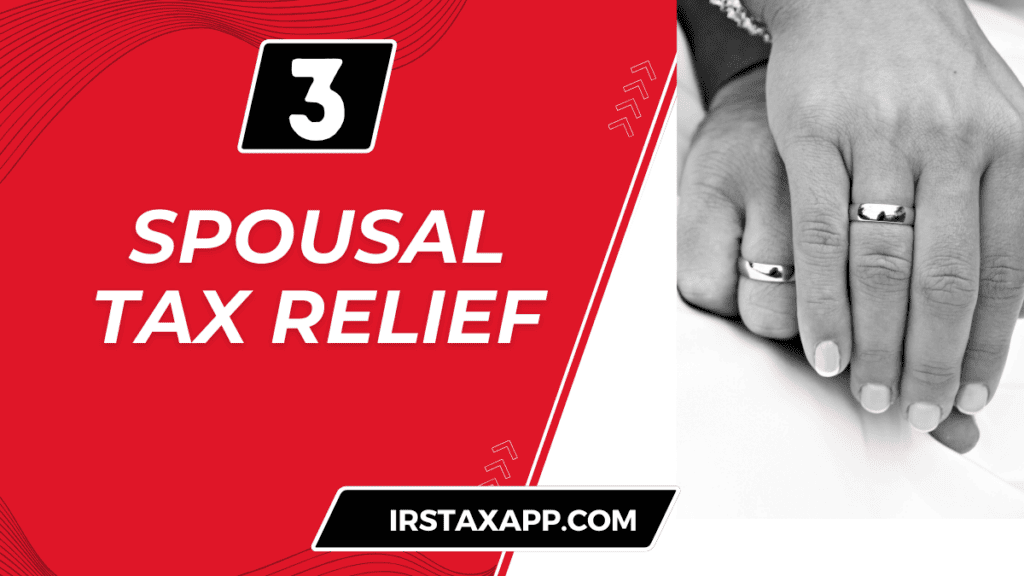
Marriage is a responsibility! The Federal tax law takes this seriously and literally. So, when you are married and filing a joint tax return, the Internal Revenue Code makes you liable for tax, interest, and penalty on the joint tax return “jointly and severally “, even if you are divorced! However, the IRC also provides three specific reliefs to a spouse from tax liabilities from the joint tax return filed when your marriage was valid. This post will discuss these three spousal tax reliefs and how they can be applied to protect the financial well-being of spouses.
1. Innocent Spouse Relief
The first relief to a spouse is “Innocent Spouse Relief“, as outlined in IRC Section 6015(b), which allows a spouse to be relieved from liability if, at the time they signed the joint return, they did not know—and had no reason to know—that there was an understatement of tax.
3 Conditions to fulfill to qualify for “innocent spouse relief.”
- There must be a joint return with an understatement of tax due to their spouse’s erroneous items, including unreported income received by the non-innocent spouse or incorrect deductions, credits, or basis claimed by the non-innocent spouse.
- You must establish that at the time of signing the joint return, you didn’t know and had no reason to know that there was an understatement for any reason whatsoever, and
- You must substantiate your claim by explaining IRS all the facts and circumstances about your “innocence” and that, in the fairness of things, you should not be held responsible for the “understatement” in the joint tax return. Among many factors that the IRS will consider, one significant point is if you are a substantial beneficiary of that “understatement”.
For example, let us say, Sarah and John filed a joint tax return. John, who handled the finances, underreported their income by not including money he earned from a freelance job. Sarah, not involved in the finances and unaware of John’s additional income, signed the tax return trusting that John had reported everything accurately. When the IRS discovered the discrepancy, they demanded additional tax, interest, and penalties.
Sarah can apply for Innocent Spouse Relief by filing Form 8857. She would need to prove that she did not know, nor had any reason to know, about the unreported income. If she can convince the IRS that it would be unfair to hold her responsible for the additional tax, interest, and penalties, the IRS may grant her innocent spouse relief, and she will not be held liable for the understated tax related to John’s freelance income.
2. Separation of Liability Relief
IRC Section 6015(c) outlines the second relief to a spouse under which the tax liability between the spouses is divided as if they had filed separately. To qualify for “Separation of Tax Liability Relief”, you must prove that :
- you are divorced, legally separated, or living apart for at least 12 months, and
- you did not know the items giving rise to the deficiency when signing the joint tax return.
Example :
Emily and Mike are divorced. During their marriage, Mike operated a small business and failed to report $20,000 in income on their joint tax return. After the divorce, the IRS audited their return and assessed additional tax, interest, and penaltiesEmily, who is now divorced and was unaware of the unreported income, can apply for Separation of Liability Relief. If granted, the IRS would allocate the additional tax liability between Emily and Mike based on the income each was responsible for. Emily would only be responsible for the tax related to her income, not the tax associated with Mike’s business.
3. Equitable Relief
The third type of relief is Equitable Relief, governed by IRC Section 6015(f). This is a catch-all category, providing relief when neither Innocent Spouse Relief nor Separation of Liability Relief applies. To qualify, the spouse must show that it would be unfair to hold them liable for the tax liability under all the facts and circumstances of the abusive partner or that the non-innocent spouse had all the financial control or other factors that contributed to the tax issue.
Example:
Linda and Tom filed a joint return, but Tom, who was controlling and abusive, refused to pay the tax liability despite having the funds to do so. Linda, who was financially dependent on Tom and afraid to confront him, was left in a difficult position when the IRS started collection activities.
In such a scenario, Linda can apply for Equitable Relief, arguing that, under the circumstances, it would be unfair to hold her liable for the tax debt. She would need to provide evidence of the abuse and her lack of financial control. If the IRS finds that holding Linda responsible for the tax liability would be inequitable, they may grant her relief, protecting her from collection activities related to the joint tax debt.
How to Apply for Spousal Tax Relief
The process for requesting spousal tax relief in the United States, regardless of the type of relief sought, starts with the same Form 8857: Request for Innocent Spouse Relief. You may also be given to fill out another form, Form 12508: Questionnaire for Requesting Spouse.
While Form 8857 is the primary form used to request spousal tax relief, the IRS may also ask you to fill out Form 12508, Questionnaire for Requesting Spouse, which helps the IRS gather additional information necessary to decide on your request for relief.
Post Disclaimer
While the information on this site - Internal Revenue Code Simplified-is about legal issues, it is not legal advice or legal representation. Because of the rapidly changing nature of the law and our reliance upon outside sources, we make no warranty or guarantee of the accuracy or reliability of information contained herein.


